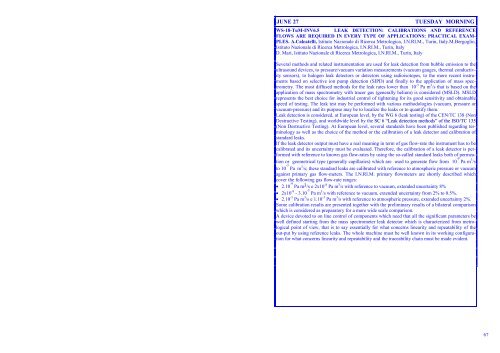Wüest M. 51 Wykes M. 82 Yamaguchi M. 17 Ybarra G. 129 Yubero F ...
Wüest M. 51 Wykes M. 82 Yamaguchi M. 17 Ybarra G. 129 Yubero F ...
Wüest M. 51 Wykes M. 82 Yamaguchi M. 17 Ybarra G. 129 Yubero F ...
You also want an ePaper? Increase the reach of your titles
YUMPU automatically turns print PDFs into web optimized ePapers that Google loves.
JUNE 27 TUESDAY MORNING<br />
WS-18-TuM-INV6.5 LEAK DETECTION: CALIBRATIONS AND REFERENCE<br />
FLOWS ARE REQUIRED IN EVERY TYPE OF APPLICATIONS: PRACTICAL EXAM-<br />
PLES. A.Calcatelli, Istituto Nazionale di Ricerca Metrologica, I.N.RI.M., Turin, Italy.M.Bergoglio,<br />
Istituto Nazionale di Ricerca Metrologica, I.N.RI.M., Turin, Italy<br />
D. Mari, Istituto Nazionale di Ricerca Metrologica, I.N.RI.M., Turin, Italy<br />
Several methods and related instrumentation are used for leak detection from bubble emission to the<br />
ultrasound devices, to pressure/vacuum variation measurements (vacuum gauges, thermal conductivity<br />
sensors), to halogen leak detectors or detectors using radioisotopes, to the more recent instruments<br />
based on selective ion pump detection (SIPD) and finally to the application of mass spectrometry.<br />
The most diffused methods for the leak rates lower than 10 -3 Pa m 3 /s that is based on the<br />
application of mass spectrometry with tracer gas (generally helium) is considered (MSLD). MSLD<br />
represents the best choice for industrial control of tightening for its good sensitivity and obtainable<br />
speed of testing. The leak test may be performed with various methodologies (vacuum, pressure or<br />
vacuum-pressure) and its purpose may be to localize the leaks or to quantify them.<br />
Leak detection is considered, at European level, by the WG 6 (leak testing) of the CEN/TC 138 (Non<br />
Destructive Testing), and worldwide level by the SC 6 “Leak detection methods” of the ISO/TC 135<br />
(Non Destructive Testing). At European level, several standards have been published regarding terminology<br />
as well as the choice of the method or the calibration of a leak detector and calibration of<br />
standard leaks.<br />
If the leak detector output must have a real meaning in term of gas flow-rate the instrument has to be<br />
calibrated and its uncertainty must be evaluated. Therefore, the calibration of a leak detector is performed<br />
with reference to known gas flow-rates by using the so-called standard leaks both of permeation<br />
or geometrical type (generally capillaries) which are used to generate flow from 10 -9 Pa m 3 /s<br />
to 10 -3 Pa m 3 /s; these standard leaks are calibrated with reference to atmospheric pressure or vacuum<br />
against primary gas flow-meters. The I.N.RI.M. primary flowmeters are shortly described which<br />
cover the following gas flow-rate ranges:<br />
• 2.10 -9 Pa m3/s e 2x10 -8 Pa m 3 /s with reference to vacuum, extended uncertainty 8%<br />
• 2x10 -8 - 3.10 -5 Pa m 3 /s with reference to vacuum, extended uncertainty from 2% to 0.5%.<br />
• 2.10 -5 Pa m 3 /s e 1.10 -3 Pa m 3 /s with reference to atmospheric pressure, extended uncertainty 2%.<br />
Some calibration results are presented together with the preliminary results of a bilateral comparison<br />
which is considered as preparatory for a more wide scale comparison.<br />
A device devoted to on line control of components which need that all the significant parameters be<br />
well defined starting from the mass spectrometer leak detector which is characterized from metrological<br />
point of view, that is to say essentially for what concerns linearity and repeatability of the<br />
out-put by using reference leaks. The whole machine must be well known in its working configuration<br />
for what concerns linearity and repeatability and the traceability chain must be made evident.<br />
67
















